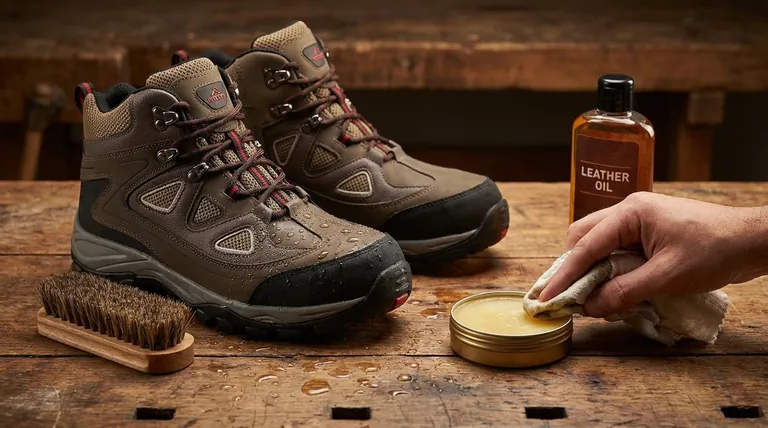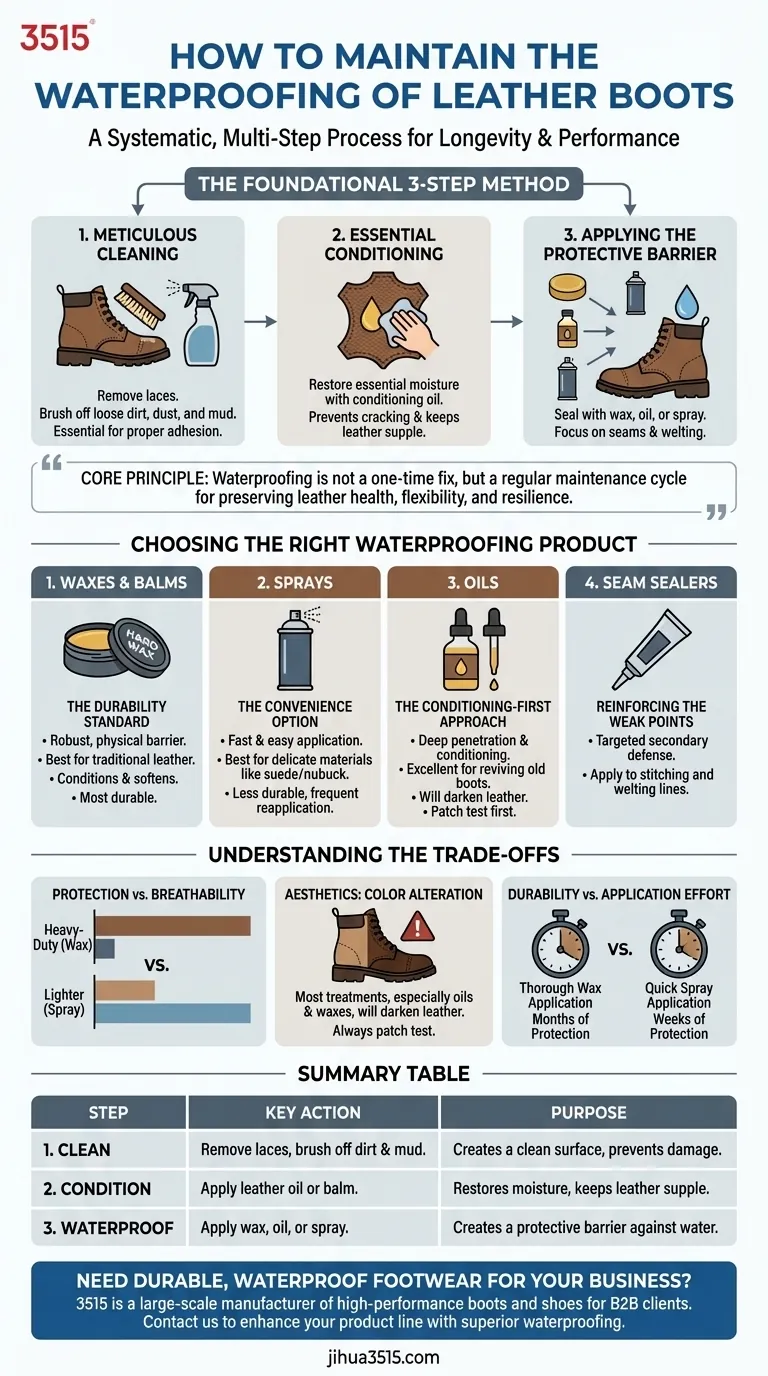To maintain the waterproofing of leather boots, you must adopt a systematic, multi-step process. This involves thoroughly cleaning the leather, conditioning it to prevent cracking, and then applying a dedicated waterproofing treatment like wax, oil, or a specialized spray to create a protective barrier against moisture.
The core principle of waterproofing is not a one-time fix, but a regular maintenance cycle. You are not just blocking water; you are actively preserving the leather's health, ensuring it remains both flexible and resilient for its entire lifespan.

The Foundational 3-Step Method
Proper maintenance is a predictable routine. Skipping any of these steps compromises the effectiveness of the final result and can shorten the life of your boots.
Step 1: Meticulous Cleaning
Before applying any product, the leather must be completely clean. Applying wax or oil over dirt grinds abrasive particles into the material, damaging the fibers and creating weak points.
First, remove the laces to ensure you can access the entire boot, including the tongue. Then, use a brush to knock off all loose dirt, dust, and mud.
Step 2: Essential Conditioning
Leather is a natural skin that can dry out, become stiff, and eventually crack. A conditioning oil restores essential moisture, keeping the leather supple and strong.
Applying a conditioner prepares the leather to properly absorb the waterproofing treatment. Note that many oils can slightly darken the color of the leather.
Step 3: Applying the Protective Barrier
This is the final step that seals the leather from the elements. The type of product you use depends on your boot material and desired level of protection.
This treatment should cover the entire boot, with special attention paid to seams and welting, which are the most common points for water intrusion.
Choosing the Right Waterproofing Product
The market offers several types of products, each with distinct advantages and use cases. Selecting the correct one is critical for effective and lasting protection.
Wax and Balms: The Durability Standard
Boot wax provides a robust, physical barrier that sits on the surface of the leather. It offers the most durable and long-lasting waterproof seal.
Wax also conditions and softens the leather as it's applied, making it an excellent all-in-one solution for traditional, smooth-leather work or hiking boots.
Sprays: The Convenience Option
Spray-on treatments are fast and easy to apply, making them a convenient choice. However, they are typically less durable than waxes and require more frequent reapplication.
Sprays are often the best or only option for delicate materials like suede or nubuck, which would be damaged by heavy waxes or oils.
Oils: The Conditioning-First Approach
Waterproofing oils penetrate deep into the leather to condition while also providing a high degree of water resistance.
They are excellent for restoring older, drier boots but will almost always darken the leather's appearance. Always perform a patch test in an inconspicuous area first.
Seam Sealers: Reinforcing the Weak Points
No matter how well you treat the leather, water can still penetrate through the stitching in the seams.
Applying a dedicated seam sealer to the welting and stitching lines provides a crucial secondary defense, fortifying the boot's most vulnerable areas.
Understanding the Trade-offs
Effective waterproofing involves balancing competing factors. Understanding these compromises allows you to choose a strategy that aligns with your specific needs.
Protection vs. Breathability
Heavy-duty treatments like wax offer maximum water protection but can reduce the leather's natural breathability.
If you frequently wear your boots in warm conditions, a lighter spray might be preferable to maintain better airflow, even if it means reapplying it more often.
Aesthetics: Color Alteration is Common
Nearly all conditioners and waterproofing agents, especially oils and waxes, can alter the color of your boots, typically making them darker.
A patch test is not optional; it is a critical step to ensure you are happy with the final appearance before treating the entire boot.
Durability vs. Application Effort
A thorough wax application takes more time and effort but provides protection that can last for months.
A spray application is quick and takes only a few minutes, but its protective layer may only last a few weeks, depending on use.
Making the Right Choice for Your Boots
Your goal determines the best maintenance strategy. Tailor your approach based on how you use your boots.
- If your primary focus is maximum durability for harsh conditions: Choose a heavy-duty boot wax and apply a dedicated seam sealer to the welts.
- If your primary focus is speed and convenience for casual wear: Use a high-quality, silicone-free waterproofing spray and reapply it regularly.
- If your primary focus is reviving old, stiff boots: Begin with a deep conditioning oil to restore flexibility before applying a final wax or spray sealant.
Consistent care is the true key to ensuring your boots protect you for years to come.
Summary Table:
| Step | Key Action | Purpose |
|---|---|---|
| 1. Clean | Remove laces, brush off dirt & mud. | Creates a clean surface for treatment, prevents damage. |
| 2. Condition | Apply leather oil or balm. | Restores moisture, keeps leather supple and strong. |
| 3. Waterproof | Apply wax, oil, or spray sealant. | Creates a protective barrier against water and elements. |
Need Durable, Waterproof Footwear for Your Business?
As a large-scale manufacturer, 3515 produces a comprehensive range of high-performance boots and shoes for distributors, brand owners, and bulk clients. Our expertise ensures your products are built to last with superior waterproofing from the start.
Contact our team today to discuss your footwear needs and discover how we can enhance your product line with reliable, high-quality manufacturing.
Visual Guide

Related Products
- Safety Footwear Wholesale Manufacturer for Custom OEM/ODM Production
- Durable Waterproof Rain Boots | Custom Manufacturer for Wholesale & Brands
- Premium Wholesale Waterproof Safety Boots High Performance Protection for Industrial Markets
- Premium Flame-Retardant Waterproof Safety Boots and Shoes
- Wholesale Leather Ankle Boots with Lug Soles for Custom Brand Manufacturing
People Also Ask
- What do heavy duty boots do? Protect Your Feet in Demanding Work Environments
- What are OSHA approved shoes? Understanding the Correct Standards for Workplace Safety
- How long can you wear safety boots? The Lifespan is Determined by Wear, Not Time
- What are the differences between steel toe, composite toe, and alloy toe Wellington boots? Choose the Right Safety Toe for Your Job
- How do safety shoes contribute to cost savings for companies? A Strategic Investment in Risk and Cost Management



















